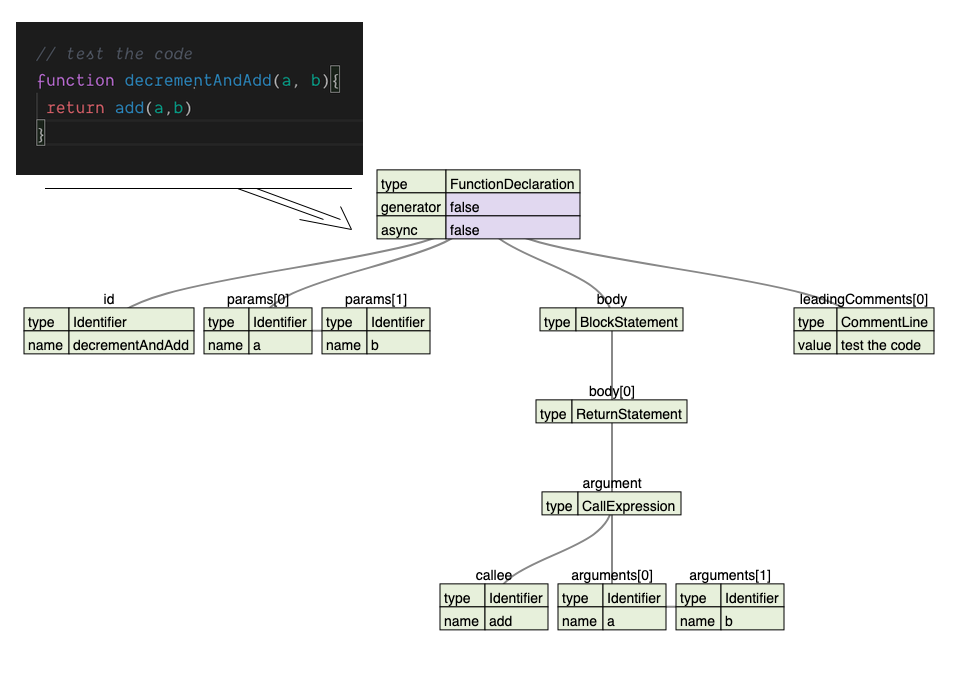介绍
假设你有一个大JavaScript文件,它来自旧时代,它长达7万行,你需要使用webpack或consorts来分割它,然后你需要知道它暴露于全球范围的函数或常数。
让计算机阅读您的代码,并从中提取您想要的内容。
它是 Abstract Syntax Trees (AST) 的工作。

我们的任务,如果您选择接受它,将是提取在全球范围内暴露的所有函数的名称。
1[label test.js]
2// test the code
3function decrementAndAdd(a, b) {
4 function add(c, d) {
5 return c + d;
6 }
7 a--;
8 b = b - 1;
9 return add(a,b)
10}
11
12// test the code
13function incrementAndMultiply(a, b) {
14 function multiply(c, d) {
15 return c * d;
16 }
17 a++;
18 b = b + 1;
19 return multiply(a, b)
20}
结果应该是(decrementAndAdd,incrementAndMultiply`)。
破解代码
一个 AST 是对 JavaScript 的解析代码的结果.对于 JavaScript,一个 AST 是包含源的树形表示的 JavaScript 对象. 在我们使用它之前,我们必须创建它. 根据我们解析的代码,我们选择合适的解析器。
在这里,由于代码是 ES5 兼容的,我们可以选择``解析器。
以下是一些最著名的开源 ECMAScript 解析器:
| Parser | Supported Languages | GitHub |
|---|---|---|
| acorn | esnext & JSX (using acorn-jsx) | https://github.com/acornjs/acorn |
| esprima | esnext & older | https://github.com/jquery/esprima |
| cherow | esnext & older | https://github.com/cherow/cherow |
| espree | esnext & older | https://github.com/eslint/espree |
| shift | esnext & older | https://github.com/shapesecurity/shift-parser-js |
| babel | esnext, JSX & typescript | https://github.com/babel/babel |
| TypeScript | esnext & typescript | https://github.com/Microsoft/TypeScript |
所有的解析器都是一样的,给它一些代码,得到一个AST。
1const { Parser } = require('acorn')
2
3const ast = Parser.parse(readFileSync(fileName).toString())
TypeScript 解析器语法略有不同,但它是好的 在这里记录。
这是通过@babel/parser解析获得的树:

1[label test-2.js]
2// test the code
3function decrementAndAdd(a, b) {
4 return add(a, b)
5}
穿越
为了找到我们要提取的内容,通常最好不要一次处理整个AST,这将是一个具有数千个节点的大型对象,即使是小型代码片段。
最好的方法是只过滤一个关心的代币。
再次,有很多工具可用于执行此 traversing 部分. 对于我们的例子,我们将使用 recast。 它非常快,具有保持代码的版本未受影响的优势. 这样,它可以返回您想要的代码的部分,其原始格式。
当我们穿越时,我们会找到所有功能代币,这就是为什么我们使用visitFunctionDeclaration方法的原因。
如果我们想看看变量分配,我们会使用visitAssignmentExpression。
1[label recast-acorn-example.js]
2const recast = require('recast');
3const { Parser } = require('acorn');
4
5const ast = Parser.parse(readFileSync(fileName).toString());
6
7recast.visit(
8 ast,
9 {
10 visitFunctionDeclaration: (path) => {
11 // the navigation code here...
12
13 // return false to stop at this depth
14 return false;
15 }
16 }
17)
节点类型
通常,代币类型的名称并不明显,你可以使用 ast-explorer来搜索所研究的类型,只需在左侧的面板上插入你的代码,选择你正在使用的分析器,然后选择voilà!。
Shallow 或 深
我们并不总是想看树的每一个层次,有时我们想做一个深入的搜索,而其他时候我们只是想看顶层,取决于框架,语法不同。
通过重置,如果我们想停止在当前的深度搜索,只需在完成时返回错误 这是我们之前所做的。
使用@babel/traverse不需要告诉babel在哪里继续,只需要指定在哪里停止返回错误声明。
1[label recast-acorn-example.js]
2recast.visit(
3 ast,
4 {
5 visitFunctionDeclaration: (path) => {
6 // deal with the path here...
7
8 // run the visit on every child node
9 this.traverse(path);
10 }
11 }
12)
我们从一个非常广泛的搜索到一个较小的样本,我们现在可以提取我们需要的数据。
从路径导航到节点,到财产
向visitFunctionDeclaration传递的路径对象是NodePath。这个对象代表了父母和孩子的AST节点之间的连接,这种路径本身对我们无用,因为它代表了函数声明和函数体之间的连接。
使用ast-explorer,我们可以找到我们正在寻找的路径的内容。
经典的做法是:‘path.node’. 它会在父母与孩子关系中找到孩子的节点. 如果您选择搜索函数,则在‘path.node’中的节点将是类型的‘Function’:
1[label recast-acorn-example.js]
2const functionNames = [];
3
4recast.visit(
5 ast,
6 {
7 visitFunctionDeclaration: (path) => {
8 console.log(path.node.type); // will print "FunctionDeclaration"
9 functionNames.push(path.node.id.name); // will add the name of the function to the array
10
11 // return false to avoid looking inside of the functions body
12 // we stop our search at this level
13 return false;
14 }
15 }
16)
尝试将交叉函数相互包装,以查看子树。下面的代码将返回每个正確位于第二层的函数。
1[label recast-acorn-example.js]
2const functionNames = [];
3
4recast.visit(
5 ast,
6 {
7 visitFunctionDeclaration: (path) => {
8 let newPath = path.get('body');
9
10 // subtraversing
11 recast.visit(
12 newPath,
13 {
14 visitFunctionDeclaration: (path) => {
15 functionNames.push(path.node.id.name);
16 return false;
17 }
18 }
19 )
20
21 // return false to not look at other functions contained in this function
22 // leave this role to the sub-traversing
23 return false;
24 }
25 }
26)
任务完成了!!!
我们可以很容易地找到参数或暴露变量的名称。
词典
AST节点 一棵树中的一个对象. 示例:函数声明,变量分配,对象表达式
NodePath 连接一个家长节点和一个树上的儿童节点
NodeProperty节点的定义部分. 根据节点,一个人可能只有一个名字或更多的信息